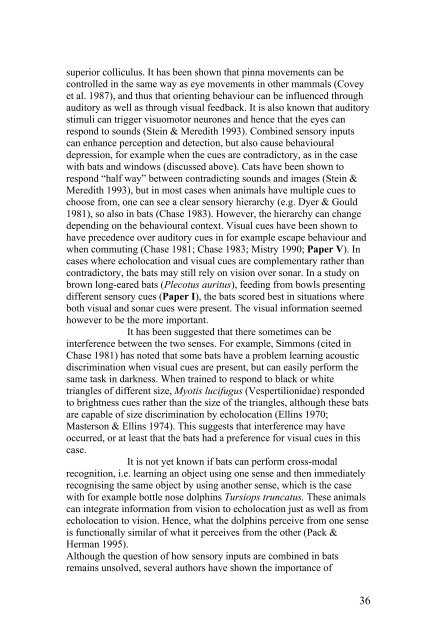Vision in echolocating bats - Fladdermus.net
Vision in echolocating bats - Fladdermus.net
Vision in echolocating bats - Fladdermus.net
Create successful ePaper yourself
Turn your PDF publications into a flip-book with our unique Google optimized e-Paper software.
superior colliculus. It has been shown that p<strong>in</strong>na movements can be<br />
controlled <strong>in</strong> the same way as eye movements <strong>in</strong> other mammals (Covey<br />
et al. 1987), and thus that orient<strong>in</strong>g behaviour can be <strong>in</strong>fluenced through<br />
auditory as well as through visual feedback. It is also known that auditory<br />
stimuli can trigger visuomotor neurones and hence that the eyes can<br />
respond to sounds (Ste<strong>in</strong> & Meredith 1993). Comb<strong>in</strong>ed sensory <strong>in</strong>puts<br />
can enhance perception and detection, but also cause behavioural<br />
depression, for example when the cues are contradictory, as <strong>in</strong> the case<br />
with <strong>bats</strong> and w<strong>in</strong>dows (discussed above). Cats have been shown to<br />
respond “half way” between contradict<strong>in</strong>g sounds and images (Ste<strong>in</strong> &<br />
Meredith 1993), but <strong>in</strong> most cases when animals have multiple cues to<br />
choose from, one can see a clear sensory hierarchy (e.g. Dyer & Gould<br />
1981), so also <strong>in</strong> <strong>bats</strong> (Chase 1983). However, the hierarchy can change<br />
depend<strong>in</strong>g on the behavioural context. Visual cues have been shown to<br />
have precedence over auditory cues <strong>in</strong> for example escape behaviour and<br />
when commut<strong>in</strong>g (Chase 1981; Chase 1983; Mistry 1990; Paper V). In<br />
cases where echolocation and visual cues are complementary rather than<br />
contradictory, the <strong>bats</strong> may still rely on vision over sonar. In a study on<br />
brown long-eared <strong>bats</strong> (Plecotus auritus), feed<strong>in</strong>g from bowls present<strong>in</strong>g<br />
different sensory cues (Paper I), the <strong>bats</strong> scored best <strong>in</strong> situations where<br />
both visual and sonar cues were present. The visual <strong>in</strong>formation seemed<br />
however to be the more important.<br />
It has been suggested that there sometimes can be<br />
<strong>in</strong>terference between the two senses. For example, Simmons (cited <strong>in</strong><br />
Chase 1981) has noted that some <strong>bats</strong> have a problem learn<strong>in</strong>g acoustic<br />
discrim<strong>in</strong>ation when visual cues are present, but can easily perform the<br />
same task <strong>in</strong> darkness. When tra<strong>in</strong>ed to respond to black or white<br />
triangles of different size, Myotis lucifugus (Vespertilionidae) responded<br />
to brightness cues rather than the size of the triangles, although these <strong>bats</strong><br />
are capable of size discrim<strong>in</strong>ation by echolocation (Ell<strong>in</strong>s 1970;<br />
Masterson & Ell<strong>in</strong>s 1974). This suggests that <strong>in</strong>terference may have<br />
occurred, or at least that the <strong>bats</strong> had a preference for visual cues <strong>in</strong> this<br />
case.<br />
It is not yet known if <strong>bats</strong> can perform cross-modal<br />
recognition, i.e. learn<strong>in</strong>g an object us<strong>in</strong>g one sense and then immediately<br />
recognis<strong>in</strong>g the same object by us<strong>in</strong>g another sense, which is the case<br />
with for example bottle nose dolph<strong>in</strong>s Tursiops truncatus. These animals<br />
can <strong>in</strong>tegrate <strong>in</strong>formation from vision to echolocation just as well as from<br />
echolocation to vision. Hence, what the dolph<strong>in</strong>s perceive from one sense<br />
is functionally similar of what it perceives from the other (Pack &<br />
Herman 1995).<br />
Although the question of how sensory <strong>in</strong>puts are comb<strong>in</strong>ed <strong>in</strong> <strong>bats</strong><br />
rema<strong>in</strong>s unsolved, several authors have shown the importance of<br />
36


